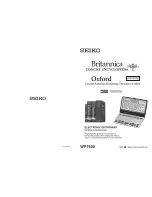
Using, Creating and Editing
V
oices
Voice Creating (Voice Set)
CGP-1000 Owner’s Manual
100
Editable Parameters in the VOICE SET Displays
The following covers in detail the editable parameters that are set in the displays
explained in step 3 of the “Basic Procedure” on page 99. The Voice Set parameters
are organized into five different displays. The parameters in each display are
described separately, below. These are also treated as part of the Voice Set parame-
ters (page 106), which are automatically called up when the Voice is selected.
PIANO
This display is available only when the Natural! piano Voice (page 78) is selected.
COMMON
CONTROLLER
1. MODULATION
When a pedal function is assigned to MODULATION, the pedal can be used to
modulate the parameters below as well as the pitch (vibrato). Here, you can set the
degree to which the pedal modulates each of the following parameters.
The available parameters differ
depending on the Voice.
Changes to velocity curve
according to Touch sensitivity
TOUCH SENSE DEPTH
Changes to velocity curve
according to VelDepth (with Off-
set set to 64)
TOUCH SENSE OFFSET
Changes to velocity curve
according to VelOffset (with
Depth set to 64)
Portamento Time:
The Portamento Time deter-
mines the pitch transition time.
Portamento is a function that cre-
ates a smooth transition in pitch
from the first note played on the
keyboard to the next.
127
127
64
64
0
Actual Velocity
for tone generator
Depth=127
(twice)
Depth=32
(half)
Depth=64
(normal)
Depth=0
Received Velocity
(Actual KeyOn speed)
64
127
0
127
64
Actual Velocity
for tone generator
Offset=96 (+64)
Offset=127
(+127)
Offset=64
(normal)
Offset=32
(-64)
Received
Velocity
(Actual
KeyOn speed)
Offset=0 (-127)
Depends on
offset
Depends on
offset
TUNING CURVE
Determines the tuning curve. Select “FLAT” if you feel the tuning
curve of the piano Voice does not quite match that of other instru-
ments Voices.
STRETCH
Tuning curve particularly for pianos
FLAT
Tuning curve in which the frequency is octave doubled over the
entire keyboard range
KEY OFF SAMPLE
Adjusts the volume of the key-off sound (the subtle sound that
occurs when you release a key).
SUSTAIN SAMPLE
Adjusts the depth of sustain sampling for the damper pedal.
STRING RESONANCE
Adjusts the depth of string resonance.
VOLUME
Adjusts the volume of the current edited Voice.
TOUCH SENSE
Adjusts the touch sensitivity (velocity sensitivity), or how greatly the
volume responds to your playing strength.
DEPTH
Determines the velocity sensitivity, or how much the level of the
voice changes in response to your playing strength (velocity).
OFFSET
Determines the amount by which received velocities are adjusted
for the actual velocity effect.
PART OCTAVE
Shifts the octave range of the edited Voice up or down in octaves.
When the edited Voice is used as any of the RIGHT 1–2 parts, the
R1/R2 parameter is available; when the edited Voice is used as the
LEFT part, the LEFT parameter is available.
MONO/POLY
Determines whether the edited Voice is played monophonically or
polyphonically (page 86).
PORTAMENTO TIME
Sets the portamento time when the edited Voice is set to “MONO” above.
FILTER
Determines the degree to which the pedal modulates the Filter Cut-
off Frequency. For details about the filter, see page 101.
AMPLITUDE
Determines the degree to which the pedal modulates the amplitude
(volume).
LFO PMOD
Determines the degree to which the pedal modulates the pitch, or
the vibrato effect.
LFO FMOD
Determines the degree to which the pedal modulates the Filter
modulation, or the wah effect.
LFO AMOD
Determines the degree to which the pedal modulates the amplitude,
or the tremolo effect.
















































